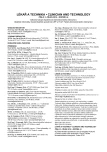Monitoring of EMG to force ratio using new designed precise wireless sensor system
This work is focused on problematic of biopotential signals measurements (EXG) using powerful SMART sensor system, composed of portable units, intended for in-time wireless measurement and evaluation of electrical activity, produced by skeletal muscles, human heart or brain. Here, we discuss very precise measurement features, which characterize this device (high gain, low noise, wireless data transfer, multi-probe measuring), some special features as low voltage and ultra-low power consumption were reached by application of the described amplifier in order to achieve its longer performance for daily use. It brings a lot of advantages to biomedical electronics and medical care. In order to optimize the performance of novel proposed smart biomedical instrument in our experimental part we have focused on measurement of surface electromyography (sEMG) signal to force ratio. These sEMG signals can illuminate our understanding of how the brain controls muscles to generate force and produce movement and can be used in such applications like as training of athletes, controlling robots, monitoring the physical capabilities of patients with motor disorders etc.
Keywords:
surface electromyography, EMG to force ratio, 2 – electrode configuration, Wireless sensor
Autoři:
Erik Vavrinsky 1; Martin Donoval 1,2; Martin Daricek 1; Frantisek Horinek 1; Marian Popovic 1; Michal Hanic 1; Martin Jagelka 1
Působiště autorů:
Institute of Electronics and Photonics, Slovak University of Technology, Ilkovicova 3, 81 19 Bratislava, Slovakia
1; NanoDesign ltd., Drotarska 19A, 811 04 Bratislava, Slovakia
2
Vyšlo v časopise:
Lékař a technika - Clinician and Technology No. 3, 2014, 44, 17-22
Kategorie:
Původní práce
Souhrn
This work is focused on problematic of biopotential signals measurements (EXG) using powerful SMART sensor system, composed of portable units, intended for in-time wireless measurement and evaluation of electrical activity, produced by skeletal muscles, human heart or brain. Here, we discuss very precise measurement features, which characterize this device (high gain, low noise, wireless data transfer, multi-probe measuring), some special features as low voltage and ultra-low power consumption were reached by application of the described amplifier in order to achieve its longer performance for daily use. It brings a lot of advantages to biomedical electronics and medical care. In order to optimize the performance of novel proposed smart biomedical instrument in our experimental part we have focused on measurement of surface electromyography (sEMG) signal to force ratio. These sEMG signals can illuminate our understanding of how the brain controls muscles to generate force and produce movement and can be used in such applications like as training of athletes, controlling robots, monitoring the physical capabilities of patients with motor disorders etc.
Keywords:
surface electromyography, EMG to force ratio, 2 – electrode configuration, Wireless sensor
Zdroje
[1] Nitish, V. Thakor. Bipotentials and Electrophysiology Measurement, CRC Press LLC. http://www.engnetbase.com, 2000.
[2] Merlo, A., Campanini, I. Technical Aspects of Surface Electromyography for Clinicians, The Open Rehabilitation Journal, 2010, 3, 98-109.
[3] Konrad, P. The ABC of EMG - A Practical Introduction to Kinesiological Electromyography, Noraxon INC. USA, 2005.
[4] Lee, K. S. EMG-Based Speech Recognition Using Hidden Markov Models With Global Control Variables, IEEE Transactions on Biomedical Engineering, Vol. 55, No. 3, 2008, pp. 930-940, ISSN 0018-9294.
[5] Merlo, A., Farina, D., Merletti, R. A Fast and Reliable Technique for Muscle Activity Detection From Surface EMG Signals, Transactions On Biomedical Engineering, Vol. 50, No. 3, 2003, pp. 316-323, ISSN 0018-9294.
[6] De Luca, C. J. Electromyography.Encyclopaedia of Medical Devices and Instrumentation. (John G. Webster Ed.) John Wiley Publisher; 2006, p. 98–109.
[7] Stegemana, D. F., Bloka, J. H., Hermensb, H. J., Roeleveldd, K. Surface EMG models: properties and applications. Journal of Electromyography and Kinesiology, Volume 10, Issue 5; 2000, p. 313–326.
[8] Quasthoff, S. Grundlagen der EMG Untersuchung, Das Neurophysiologie-Labor. Volume 32, Issue 1, 2010; p. 1–27, ISSN 1439-4847, 10.1016/j.neulab.2009.08.003.
[9] Kamen, G, Gabriel D. A. Essentials of electromyography, Champaign, IL, Human Kinetics; 2010. p. 156–158.
[10] Huhta, J. C., Webster, J.G. “60-Hz interference in electrocardiography,” IEEE Trans. Biomed. Eng., 20, 91–101, 1973.
[11] Kugelstadt, T. Getting the most out of your instrumentation amplifier design. http://www.ti.com/; 2005.
[12] Kitchin, Ch., Counts L. A Designer’s guide to instrumentation amplifiers 3RD Edition. http://www.analog.com/; 2006.
[13] Abad, S. L. M, Maghooli, K. Low supply voltage electrocardiogram signal amplifier. IEEE; 2007, p. 799-801.
[14] Texas Instruments. OPA2335 Datasheet. http://www.ti.com/; 2003.
[15] Vavrinsky, E., Rendek, K., Daricek, M., Donoval, M., Horinek, F., Horniak, M., Donoval, D. Electrode configuration for EMG measurements. In: ASDAM 2010. The Eighth International Conference on Advanced Semiconductor Devices and Microsystems.Smolenice, Piscataway: Institute of Electrical and Electronics Engineers; 2010, ISBN 978-1-4244-8572-7.
[16] Ray, G., Guha, S. Relationship between the surface e.m.g. and muscular force, Medical and Biological Engineering and Computing. Volume: 21, Issue: 5, Springer Berlin / Heidelberg; 1983, ISSN 0140-0118, p. 579-586, Doi: 10.1007/BF02442383.
[17] Enoka, R. M. Muscle fatigue – from motor units to clinical symptom, Journal of Biomechanics, Volume 45, Issue 3; 2012, p. 427–433.
[18] Calvert, T. W, Chapman, A. E. The Relationship Between the surface EMG and Force Transients in Muscle: Simulation and Experimental Studies, Proceedings of the IEEE, VOL 65, NO.5; 1977.
[19] Labchart. ADInstruments, http://www.adinstruments.com/, 2012.
Štítky
BiomedicínaČlánok vyšiel v časopise
Lékař a technika

2014 Číslo 3
Najčítanejšie v tomto čísle
- Vliv průtočného odporu dýchacích cest a alveolární poddajnosti na dechový objem při vysokofrekvenční oscilační ventilaci
- Health Technology Assessment for Medical Devices
- Monitoring of EMG to force ratio using new designed precise wireless sensor system
- Remote Pulse Oximetry Imaging – Fundamentals and Applications
